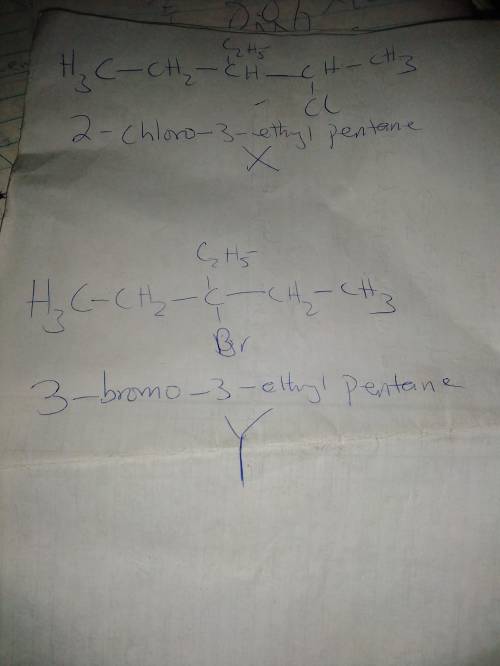
Chemistry, 16.11.2020 16:50 crispingolfer1864
Compounds X has the formula C7H15Cl; Y is C7H15Br. X undergoes base-promoted E2 elimination to give a single alkene product Z. Y likewise reacts under similar conditions to give a single alkene product that is isomeric with Z Catalytic hydrogenation of Z affords 3-ethylpentane. X readily reacts in SN2 fashion with sodium iodide in acetone. Y does not undergo a similar SN2 reaction. Propose structures for X and Y.

Answers: 2


Another question on Chemistry

Chemistry, 22.06.2019 12:00
Give the set of reactants (including an alkyl halide and a nucleophile) that could be used to synthesize the following ether: draw the molecules on the canvas by choosing buttons from the tools (for bonds and charges), atoms, and templates toolbars, including charges where needed. ch3ch2och2ch2chch3 | ch3
Answers: 1

Chemistry, 22.06.2019 12:10
Consider the reaction: n2(g) + o2(g) ⇄ 2no(g) kc = 0.10 at 2000oc starting with initial concentrations of 0.040 mol/l of n2 and 0.040 mol/l of o2, calculate the equilibrium concentration of no in mol/l how would this be done?
Answers: 3


Chemistry, 22.06.2019 23:50
Be sure to answer all parts. the following equilibrium constants were determined at 1123 k: c(s) + co2(g) ⇌ 2co(g) k'p = 1.30 × 1014 co(g) + cl2(g) ⇌ cocl2(g) k''p = 6.00 × 10−3 calculate the equilibrium constant at 1123 k for the reaction: c(s) + co2(g) + 2cl2(g) ⇌ 2cocl2(g) 4.68 × 10 9 (enter your answer in scientific notation.) write the equilibrium constant expression, kp:
Answers: 3
You know the right answer?
Compounds X has the formula C7H15Cl; Y is C7H15Br. X undergoes base-promoted E2 elimination to give...
Questions

Social Studies, 01.11.2019 23:31


Mathematics, 01.11.2019 23:31

Health, 01.11.2019 23:31



History, 01.11.2019 23:31




Mathematics, 01.11.2019 23:31


Mathematics, 01.11.2019 23:31



Biology, 01.11.2019 23:31



History, 01.11.2019 23:31





